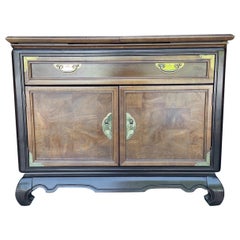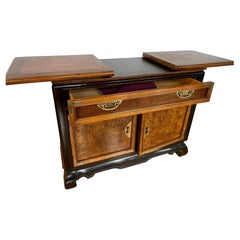Broyhill Ming Dynasty
Vintage 1970s American Ming Dry Bars
Cherry, Maple, Burl
Recent Sales
Vintage 1970s American Ming Buffets
Ash, Cherry, Maple, Olive, Burl
People Also Browsed
Late 20th Century American Chinoiserie Buffets
Wood
Vintage 1970s Chinoiserie Dry Bars
Glass, Mahogany
Vintage 1960s American Dry Bars
Wood
Broyhill for sale on 1stDibs
Founded during the 1920s, the Broyhill Furniture Company was one of the stalwart North Carolina makers of mid-priced, traditional wooden furnishings, and it served American families well. The Colonial Revival style — chairs with turned legs, beds with split pediment headboards — had always been the company’s stock in trade. But the vintage Broyhill bedroom furniture, dressers and cabinets of the postwar era are quite popular with today’s fans of mid-century modern design — particularly those who enjoy more flamboyant stylings, such as those of Adrian Pearsall.
For collectors of a certain type, Broyhill is most admired for its brief foray into the contemporary furnishings of the late 1950s and ‘60s. In 1957, responding to changing tastes, the firm launched its Broyhill Premier line with the Sculptra series.
Sculptra pieces featured decorative molding with a square-within-a-square motif and horizontal cat’s eye-shaped drawer pulls. Five years later, Broyhill introduced the Brasilia furniture group, inspired by the Oscar Niemeyer architecture for the brand-new Brazilian capital. The collection made its debut at the Seattle World’s Fair.
The cabinet door fronts of vintage Broyhill Brasilia pieces feature moldings based on the sweeping colonnades and parabolic curves of such buildings as the Palácio da Alvorada (“Palace of the Dawn”), the presidential residence. As you will see on 1stDibs, Broyhill created a striking and spirited line of furnishings that will make a happy keynote in any Atomic Age-inspired interior.
Ohio retailer Big Lots acquired the rights to the Broyhill name and related trademarks in 2019.
Find vintage Broyhill tables, credenzas, seating and other items on 1stDibs.
A Close Look at Ming Furniture
In what’s considered a golden age of Chinese furniture, Ming dynasty artisans produced expertly made designs that married elegance and function. Ming furniture was versatile, such as tables that doubled as writing desks and dining spaces. But it was also beautiful, enhancing a room with clean lines, soft curves and sophisticated decoration.
Dating from 1368 to 1644, the Ming dynasty was a vibrant time for international trade and culture. Especially for scholars and the wealthy, there was an emphasis on a home’s design to promote a good life. From large wardrobes to angular sofas, Ming-style furniture was defined by its joinery, which, instead of nails, involved meticulously designed interlocking elements of wood. This material was carefully selected and positioned to make the grain part of the design. The slow-growing huanghuali, a yellowish rosewood, was particularly valued for its bright color.
Although ornamentation was minimal, Ming dynasty furniture often featured carved or painted details of flowers, insects, dragons, fruits and other motifs. Chairs crafted for scholars could include calligraphic brush writing. As overseas trade expanded, techniques from the West, like cloisonné enamel painting, adorned table screens and other pieces.
Ming furniture influenced styles abroad such as Queen Anne in England and Hollywood Regency in the United States. The curved shape of Ming armchairs had a profound impact on legendary Scandinavian modernist furniture designer Hans Wegner. The Danish cabinetmaker shared the Ming artisans’ interest in creating streamlined, functional furnishings, and his China chair, Round chair and Wishbone chair are inspired by Ming dynasty seating. Today, the Ming-style horseshoe chair is a graceful and sought-after type of seat, and contemporary Chinese designers such as Jerry Chen and Gan Erke are also drawing on this heritage for a new era of style.
Find a collection of Ming cabinets, decorative objects, lounge chairs and other furniture on 1stDibs.
Finding the Right Storage-case-pieces for You
Of all the vintage storage cabinets and antique case pieces that have become popular in modern interiors over the years, dressers, credenzas and cabinets have long been home staples, perfect for routine storage or protection of personal items.
In the mid-19th century, cabinetmakers would mimic styles originating in the Louis XIV, Louis XV and Louis XVI eras for their dressers, bookshelves and other structures, and, later, simpler, streamlined wood designs allowed these “case pieces” or “case goods” — any furnishing that is unupholstered and has some semblance of a storage component — to blend into the background of any interior.
Mid-century modern furniture enthusiasts will cite the tall modular wall units crafted in teak and other sought-after woods of the era by the likes of George Nelson, Poul Cadovius and Finn Juhl. For these highly customizable furnishings, designers of the day delivered an alternative to big, heavy bookcases by considering the use of space — and, in particular, walls — in new and innovative ways. Mid-century modern credenzas, which, long and low, evolved from tables that were built as early as the 14th century in Italy, typically have no legs or very short legs and have grown in popularity as an alluring storage option over time.
Although the name immediately invokes images of clothing, dressers were initially created in Europe for a much different purpose. This furnishing was initially a flat-surfaced, low-profile side table equipped with a few drawers — a common fixture used to dress and prepare meats in English kitchens throughout the Tudor period. The drawers served as perfect utensil storage. It wasn’t until the design made its way to North America that it became enlarged and equipped with enough space to hold clothing and cosmetics. The very history of case pieces is a testament to their versatility and well-earned place in any room.
In the spirit of positioning your case goods center stage, decluttering can now be design-minded.
A contemporary case piece with open shelving and painted wood details can prove functional as a storage unit as easily as it can a room divider. Alternatively, apothecary cabinets are charming case goods similar in size to early dressers or commodes but with uniquely sized shelving and (often numerous) drawers.
Whether you’re seeking a playful sideboard that features colored glass and metal details, an antique Italian hand-carved storage cabinet or a glass-door vitrine to store and show off your collectibles, there are options for you on 1stDibs.
- When was Broyhill saga made?1 Answer1stDibs ExpertFebruary 13, 2023The Broyhill Saga collection was made during the 1960s and 70s. For collectors of mid-century modern design, North Carolina's Broyhill Furniture Company is most admired for its brief foray into the contemporary furnishings of the late 1950s and ‘60s. The Saga group of walnut dressers, nightstands, commodes and more were part of the Broyhill Premier line and boast the clean lines and simple forms associated with the brand's Brasilia and Sculptra pieces. The company's ads for the series touted the influence of Scandinavian modernism on the designs. Find vintage Broyhill Saga furniture on 1stDibs.
- 1stDibs ExpertApril 5, 2022Broyhill furniture is manufactured by Broyhill Furniture Industries, Inc. The company started as Lenoir Chair Company, and was later bought by Interco, Inc., which is now known as Furniture Brands International. Shop a range of Broyhill Furniture from top sellers on 1stDibs.

